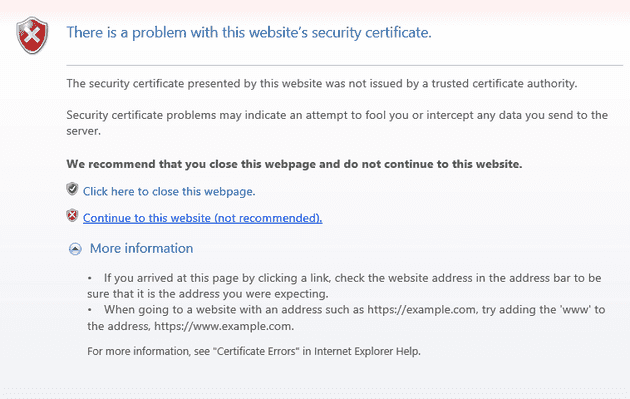Funny article name you say and I can only agree, yes 🙂 most of the time you run like hell when you see page with broken certificate. But I will explain why one might need this 🙂
My girlfriend is a tester and at her current work she is testing web apps. Since majority of these apps use SSL and she is using staging versions, she has to accept certificate errors and if you know what you are doing, than everything is OK and fine (you see errors because of self signed certificates).
Yes there are more ways how to get over this problem :
- http://security.stackexchange.com/questions/36913/adding-self-signed-certificate-to-trusted-store
- http://blogs.adobe.com/livecycle/2012/04/rights-management-how-to-get-windows-7-to-trust-a-self-signed-server-certificate.html
- http://pic.dhe.ibm.com/infocenter/doorshlp/v9r5/index.jsp?topic=%2Fcom.ibm.rational.dwa.install.doc%2Ftopics%2Ft_configureIEforSSL.html
but if you don’t want to do this/you cant do this on your box then you just have to live with basic temporary exception and you will click Continue to this website :
And now comes the problem part/our edge case. Most of the time you are accessing one URL on one server and everything works.
But lets say you have your testing URL with self signed certificate where is a page with IFRAME to different URL with different certificate on different server. Now what? You have to add two different exceptions.
The problem lies in how IE (tested in IE11) displays another page. You just don’t have any option how to add another exception, you just see that the iframed page has invalid certificate, nothing more…
The FireFox solution :
The FireFox way is more common and most of people know it (so just small recap):
you can open new tab with IFRAMEd URL, access it, see error and add permission. Than on another tab access hosting page, add second exception and you are done, all of the later visits to hosting page share the same exception. Which is nice, because you can close the tab and open different one later and you don’t need to add exception to IFRAMEd URL over and over again.
The IE (I suppose because of the architecture – more on this here – http://blogs.msdn.com/b/ie/archive/2008/03/11/ie8-and-loosely-coupled-ie-lcie.aspx ) behaves little bit differently.
The IE solution :
In IE the exception for IFRAMEd page isn’t shared between tabs/shared for whole browser instance so you have to :
- Access the IFRAMED URL and add exception and then on the very same tab
- Access the hoster URL and add second exception
and everything should work now also for IE the way expected 🙂 but once you close the tab with exceptions, you have to do the same thing again…
Decision which way is better/safer is up to you….
Hope this helps 🙂 Tested on latest versions of Windows 7 + IE11.
